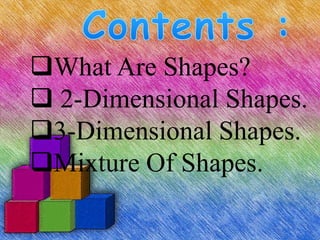Visualizing Solid Shapes
- 2. ïąWhat Are Shapes? ïą 2-Dimensional Shapes. ïą3-Dimensional Shapes. ïąMixture Of Shapes.
- 3. What Are Shapes? A shape is a geometrical figure that can be described with mathematics. One way to classify shapes is to describe a bigger shape that the shape fits inside of. For example, two-dimensional shapes like circles will fit inside of a flat plane. Three-dimensional objects like cubes will not fit inside of a plane, because they are not flat.
- 4. 2-dimensional Shapes These are two-dimensional shapes or flat plane geometry shapes. Their sides are made of straight or curved lines. They can have any number of sides. Plane figures made of lines are called polygons. Triangles and squares are examples of polygons
- 5. Properties Of 2 Dimensional Shapes Two-dimensional shapes are planar. Graphically speaking, they depend on only two coordinates--x and y, for instance-- consisting of x units and y units, respectively. In the case of a coordinate system of more than two dimensions, then a 2-D shape would still depend on two coordinate directions. For example, in a spatial xyz coordinate system (which is three- dimensional) a two-dimensional shape would be expressed with points such as (x,y,0), (x,0,z), or (0,y,z). Therefore, it would depend on either x and y, x and z, or y and z. 2-D shapes include the square, the triangle, the rhombus, etc. To understand it more easily, you can say that 2-D shapes do not have prominent or rugged parts. For example, speaking two-dimensionally you would have a square, whereas three- dimensionally you would have a cube, which is like an extended or prominent square.
- 6. 3-Dimensional Shapes A 3D shape is a solid which encloses a volume and has length, breadth and height
- 7. Properties Of 3 Dimensional Shapes Three-dimensional shapes have four properties that set them apart from two- dimensional shapes: faces, vertices, edges and volume. These properties not only allow you to determine whether the shape is two- or three-dimensional, but also which three-dimensional shape it is.










